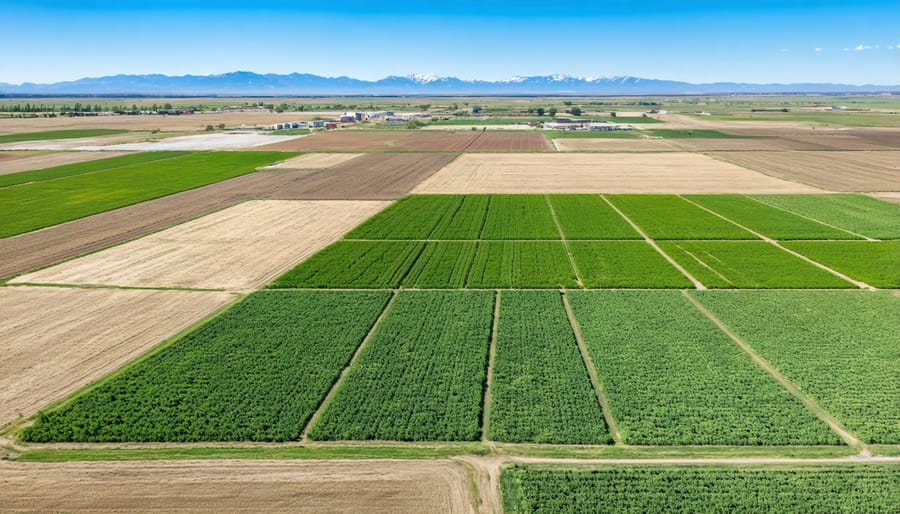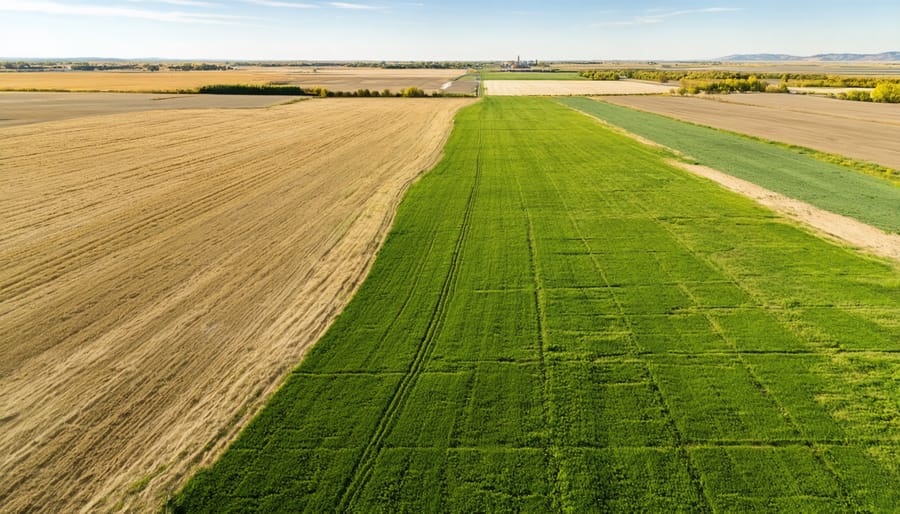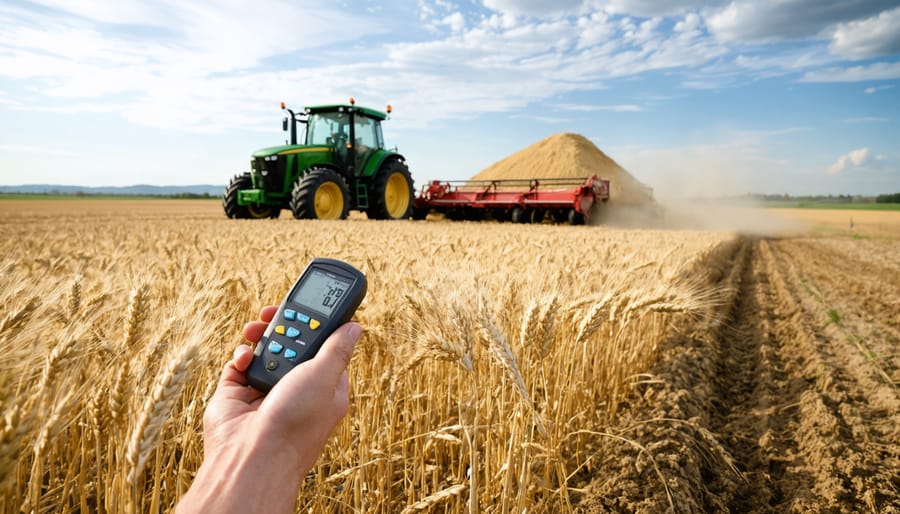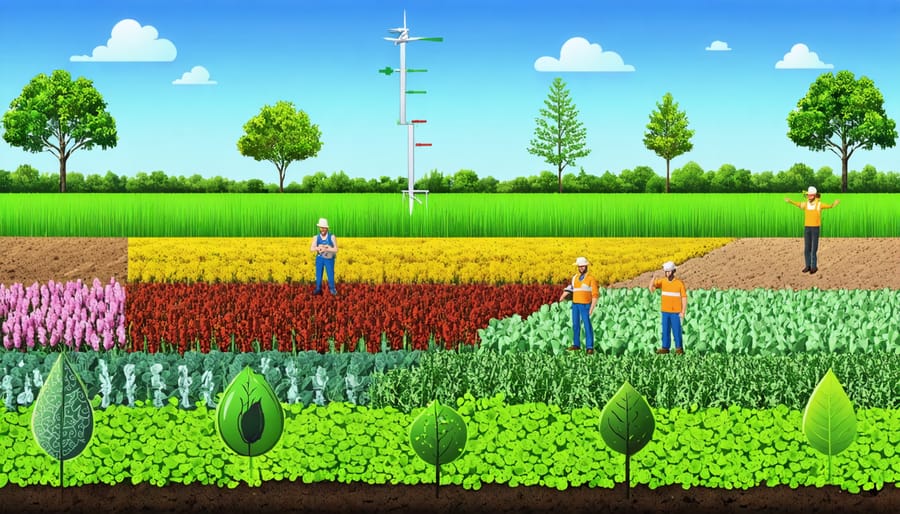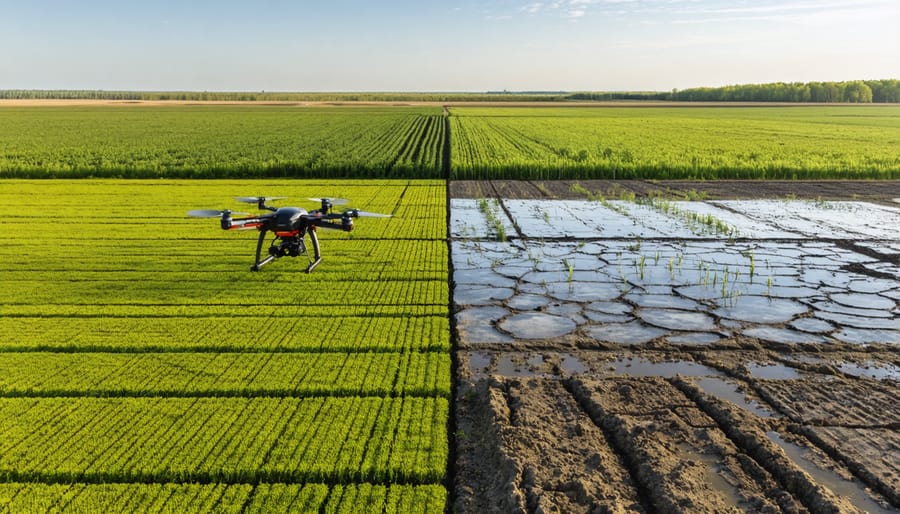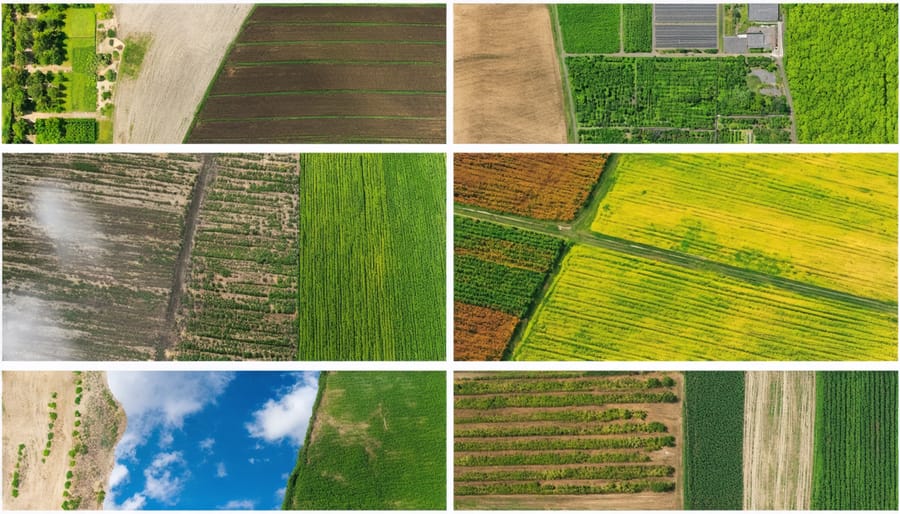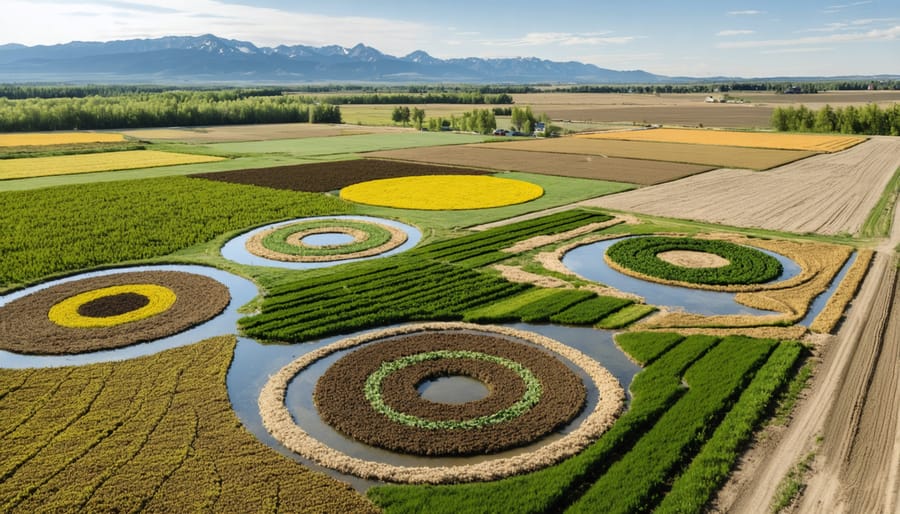Dry continental climates shape Alberta’s agricultural landscape, presenting both unique challenges and opportunities for farmers across the province. Known for their distinct seasonal temperature extremes and limited precipitation patterns, these ‘d climates’ – technically classified as Köppen climate type Dfb – create a demanding yet productive environment for Canadian agriculture. From Medicine Hat’s sun-baked fields to Grande Prairie’s northern reaches, farmers have adapted their practices to thrive in conditions where annual rainfall typically ranges from 300-450mm and growing seasons span 100-120 days. Understanding these climatic patterns becomes crucial as Alberta’s agricultural sector, worth over $9.6 billion annually, continues to evolve amidst changing weather patterns and increasing demand for sustainable farming practices. Through generations of experience and modern agricultural innovations, producers have developed resilient strategies that transform these challenging conditions into productive agricultural systems, making Alberta one of Canada’s most important food-producing regions.
Understanding Alberta’s Dry Climate Zones
Key Climate Characteristics
D climates in Alberta are characterized by distinct seasonal temperature variations and moderate precipitation patterns that significantly impact agricultural activities. Average annual precipitation ranges from 350-450mm, with approximately 70% occurring during the critical growing season between May and September. Summer temperatures typically reach 20-25°C, while winter temperatures can drop to -30°C or lower, creating a growing season that spans roughly 120 days.
These conditions require farmers to adopt climate-resilient farming practices that maximize available moisture. Spring typically brings variable conditions, with late frosts possible until mid-May, while autumn sees gradual cooling with first frosts usually occurring by mid-September.
What makes D climates unique in Alberta is the combination of cold winters with warm summers, creating specific opportunities and challenges for crop selection. The region experiences approximately 2,000-2,300 growing degree days annually, sufficient for many cool-season crops. Humidity levels remain relatively low throughout the year, which helps reduce disease pressure but can increase evaporation rates during critical growing periods.
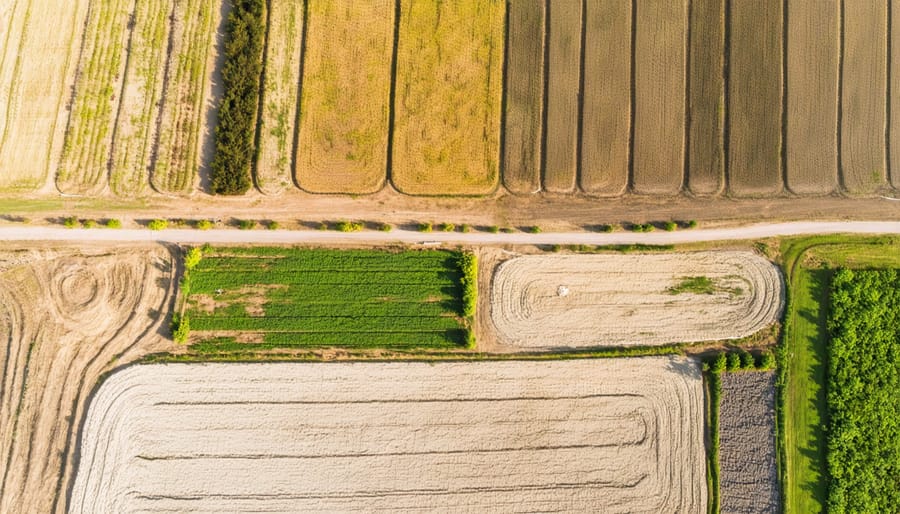
Impact on Soil Health
Dry climates significantly challenge soil health in Alberta’s agricultural regions, affecting everything from soil structure to biological activity. The limited moisture typical of these conditions leads to reduced organic matter decomposition, which can result in harder, more compacted soils that are less hospitable to crop growth. This physical degradation makes it more difficult for roots to penetrate and access essential nutrients.
The lack of consistent moisture also impacts beneficial microorganisms crucial for nutrient cycling strategies and soil fertility. These microbes become less active during dry periods, slowing down the breakdown of crop residues and the release of nutrients. Many Alberta farmers have observed that their soils require more careful management during extended dry spells to maintain productivity.
Furthermore, dry conditions can lead to increased soil salinity as water evaporates, leaving behind concentrated mineral deposits. This affects both soil structure and nutrient availability. However, with proper management practices like maintaining ground cover and implementing conservation tillage, farmers can help protect their soil’s health even in challenging dry conditions.
Proven Soil Management Strategies
Moisture Conservation Techniques
In Alberta’s dry climate, effective moisture conservation is crucial for successful crop production. Implementing techniques that enhance water infiltration and retention can significantly improve farm productivity. One proven method is stubble retention, where crop residue is left on fields after harvest, creating a protective layer that reduces evaporation and improves soil structure.
Conservation tillage practices, particularly zero-till systems, have shown remarkable success across the prairies. These approaches minimize soil disturbance, maintaining valuable organic matter and reducing moisture loss through evaporation. Many Alberta farmers report water savings of up to 30% using these methods.
Incorporating cover crops during shoulder seasons helps protect soil moisture while adding organic matter. Quick-growing species like fall rye or winter wheat are particularly effective in our climate. Strategic windbreak placement using native species like caragana or green ash can reduce wind exposure and evaporation rates across fields.
Soil amendments like composted manure improve soil structure and water-holding capacity. Local success stories show that fields treated with organic matter can retain moisture up to 40% longer than untreated areas. Timing irrigation properly and using soil moisture monitoring equipment helps optimize water use efficiency. Consider installing moisture sensors at different depths to guide irrigation decisions and prevent unnecessary water application.
Cover Cropping for Dry Climates
In Alberta’s dry climate, successful cover cropping requires careful selection of drought-tolerant species and strategic management practices. Fall rye and winter triticale have proven particularly effective, establishing strong root systems before winter and providing early spring growth. These crops can survive on minimal moisture while offering excellent soil protection.
Local farmers have found success with cocktail mixes including drought-resistant legumes like hairy vetch and field peas, combined with cool-season cereals. This combination maximizes soil benefits while sharing water resources effectively through different rooting depths.
Timing is crucial in our climate. Seeding cover crops immediately after harvest or frost-seeding in early spring helps utilize available moisture. Many Alberta producers recommend terminating cover crops earlier than in humid regions, typically when they reach 30-40 centimetres in height, to preserve soil moisture for the subsequent cash crop.
For maximum water efficiency, consider reducing seeding rates by 20-30% compared to conventional recommendations. This strategy allows individual plants adequate space and moisture while still achieving soil coverage goals. Rolling the field after seeding improves seed-to-soil contact and moisture conservation.
Innovative farmers across the province are experimenting with shorter-duration cover crops between main growing seasons. These “catch crops” provide soil benefits while using less water than full-season covers. Buckwheat and spring barley are popular choices, offering quick establishment and early termination options.
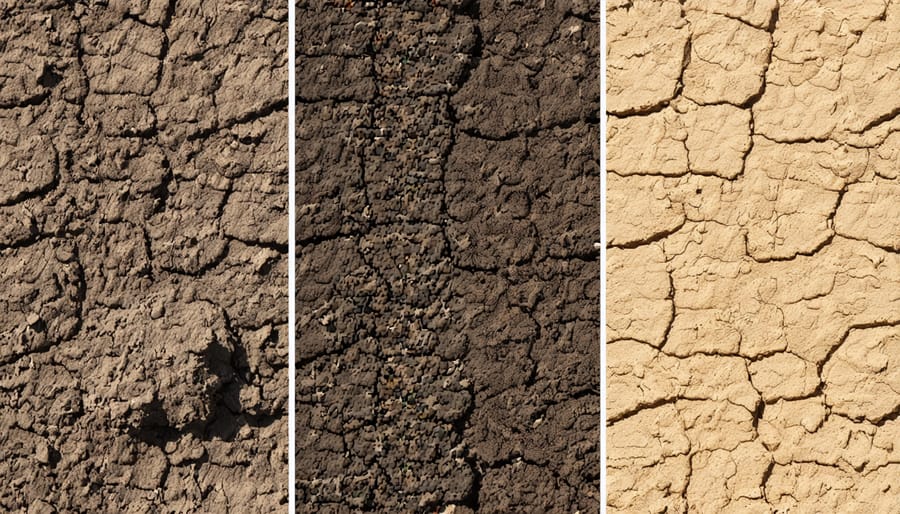
Organic Matter Management
In dry climates, maintaining organic matter requires strategic planning and consistent effort, but the rewards for soil health are substantial. Alberta farmers have developed effective soil management solutions that work well in our challenging conditions.
Cover cropping with drought-resistant species like clover and rye helps build organic matter while protecting topsoil from wind erosion. Many successful farmers in Southern Alberta integrate crop residue management, leaving at least 30% of crop residues on fields after harvest to decompose naturally and enrich the soil.
Composting is another vital strategy, with many operations creating their own using locally available materials like straw, manure, and green waste. When applied at rates of 10-15 tonnes per hectare, compost significantly improves soil structure and water retention capacity.
Reducing tillage operations helps preserve existing organic matter by minimizing soil disturbance. No-till practices, combined with careful residue management, have shown impressive results in maintaining soil organic carbon levels, even in areas receiving less than 350mm of annual rainfall.
Consider implementing rotation grazing on pasture lands, which allows plant matter to recover and contribute to soil organic matter buildup. This approach has helped many Alberta ranchers improve their soil quality while maintaining productive grazing operations.
Regular soil testing and monitoring organic matter levels helps track progress and adjust management strategies as needed. Many farmers report seeing significant improvements within 3-5 years of implementing these practices.
Real Success Stories
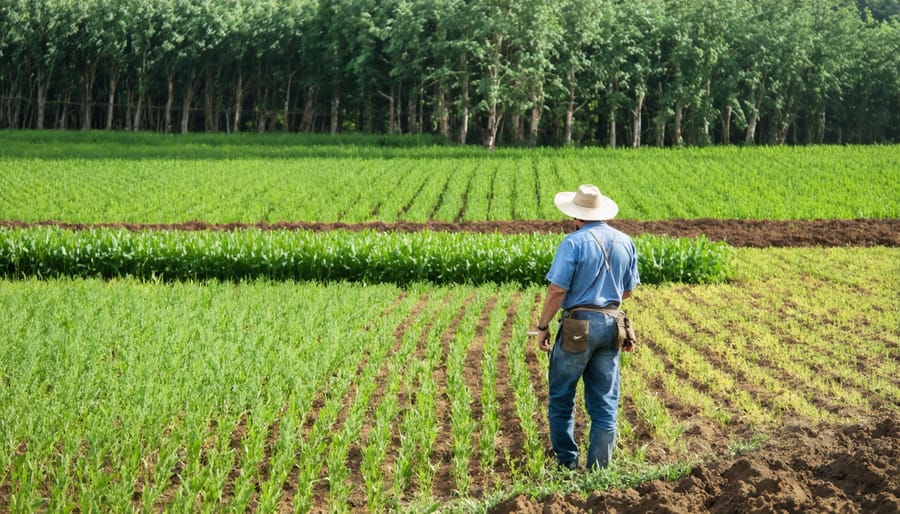
Southern Alberta Grain Farm
The Thompson family farm, located 30 kilometers east of Lethbridge, stands as a testament to successful adaptation in southern Alberta’s dry climate. Over the past decade, this third-generation farm has transformed 800 hectares of challenging terrain into thriving cropland through innovative soil management practices.
When Sarah Thompson took over operations in 2013, the farm faced recurring challenges with soil erosion and moisture retention. “Our yields were inconsistent, and we were constantly battling against the wind,” she recalls. The turning point came when she implemented a comprehensive soil health program, focusing on year-round ground cover and diverse crop rotations.
The farm now employs a mix of winter wheat, yellow peas, and canola in three-year rotations, with cover crops filling the shoulder seasons. This approach has increased organic matter in their soil from 2% to 4.5% over eight years, significantly improving water retention capacity.
Key to their success has been the adoption of minimal tillage practices and strategic stubble management. “We leave at least 60% crop residue on the surface,” explains Thompson. “This not only prevents erosion but also creates a natural moisture trap.”
The results speak for themselves: average yields have increased by 30%, while water use efficiency has improved by 40%. The farm now serves as a demonstration site for regional soil health initiatives, hosting regular field days for local farmers interested in similar transformations.
Central Alberta Mixed Operation
The Smith family farm in Red Deer County represents a successful adaptation to central Alberta’s dry climate conditions through integrated farming practices. Operating on 2,000 hectares, the Smiths combine cattle ranching with crop rotation to maximize land efficiency and soil health. Their operation demonstrates how mixed farming can thrive in areas receiving less than 450mm of annual precipitation.
Key to their success is the implementation of rotational grazing for their 300-head cattle herd across native grasslands and tame pastures. This practice allows for optimal grass recovery periods while naturally fertilizing the soil. During winter months, they utilize swath grazing techniques to reduce feed costs and maintain soil organic matter.
On the cropping side, the Smiths incorporate drought-resistant varieties of barley, canola, and pulse crops in a four-year rotation. Their adoption of minimum tillage practices and maintaining crop residue has significantly improved soil moisture retention. They’ve also installed efficient irrigation systems that utilize soil moisture monitoring technology to optimize water usage.
The farm’s approach to risk management includes maintaining feed reserves and diversifying income streams through both livestock and crops. This strategy has helped them remain resilient during dry years, with their operation serving as a model for other farmers in similar climatic conditions. Their success demonstrates how traditional farming wisdom combined with modern technology can create sustainable agricultural systems in dry climates.
Implementation Guide
Getting Started
Starting your journey toward adapting to dry climate conditions doesn’t have to be overwhelming. Begin by conducting a thorough assessment of your farm’s current situation, including soil moisture levels, existing irrigation systems, and crop performance records. Many Alberta farmers find it helpful to connect with their local agricultural extension office or join farming networks to access regional expertise and support.
The first practical step is implementing basic moisture monitoring tools, such as soil moisture probes or even simple rain gauges, to track water availability throughout your growing season. These measurements will help you make informed decisions about irrigation timing and crop selection.
Consider starting small by selecting a test plot where you can experiment with drought-resistant varieties or new irrigation methods. This approach allows you to gain confidence and experience while minimizing risk. Many successful Alberta farmers recommend beginning with about 10% of your total acreage for initial trials.
Essential equipment for getting started includes moisture meters, weather monitoring tools, and basic irrigation equipment. Most of these items are readily available through local agricultural suppliers. You’ll also want to establish relationships with soil testing laboratories and agricultural consultants who can provide guidance specific to your farm’s needs.
Remember, adaptation is a gradual process. Focus on making incremental changes and documenting your results. This methodical approach has helped countless Alberta farmers successfully transition to more resilient farming practices suited to dry conditions.
Monitoring and Adjustment
Success in dry climate farming relies heavily on consistent monitoring and timely adjustments to your agricultural practices. Start by establishing a detailed record-keeping system that tracks daily weather patterns, soil moisture levels, and crop performance. Many Alberta farmers find success using soil moisture probes at different depths, typically 30 cm, 60 cm, and 90 cm, to understand water distribution throughout the root zone.
Regular field walks, ideally early morning or late evening, help identify signs of water stress before they become severe. Look for leaf rolling, wilting, or changes in crop colour. Document these observations alongside your soil moisture readings to build a comprehensive picture of your field’s conditions.
Consider installing a small weather station on your property to monitor local precipitation, temperature, and wind patterns. This data, combined with Agriculture Canada’s weather forecasts, helps make informed decisions about irrigation timing and crop protection measures.
Adjust your management strategies based on the data you collect. If soil moisture levels drop below 50% of field capacity, consider implementing emergency irrigation or adjusting your regular watering schedule. Similarly, watch for signs that your soil conservation practices might need fine-tuning, such as wind erosion or water runoff patterns.
Remember to regularly calibrate your monitoring equipment and update your record-keeping methods. Many successful Alberta farmers recommend reviewing and adjusting your monitoring plan at least twice during the growing season to ensure it remains effective and practical.
Understanding and adapting to d climates is crucial for the success of Canadian agriculture, particularly in Alberta. By implementing appropriate water management strategies, choosing drought-resistant crops, and adopting sustainable farming practices, we can build resilient agricultural operations that thrive even in challenging conditions. The experiences of local farmers have shown that success is possible through innovation and community collaboration. As climate patterns continue to evolve, let’s work together to share knowledge, support one another, and implement these proven strategies. Remember, small changes in farming practices today can lead to significant improvements in crop yields and soil health tomorrow. Reach out to your local agricultural extension office or farming associations to learn more about specific programs and resources available in your area. Together, we can ensure the continued prosperity of Canadian agriculture in d climate regions.

